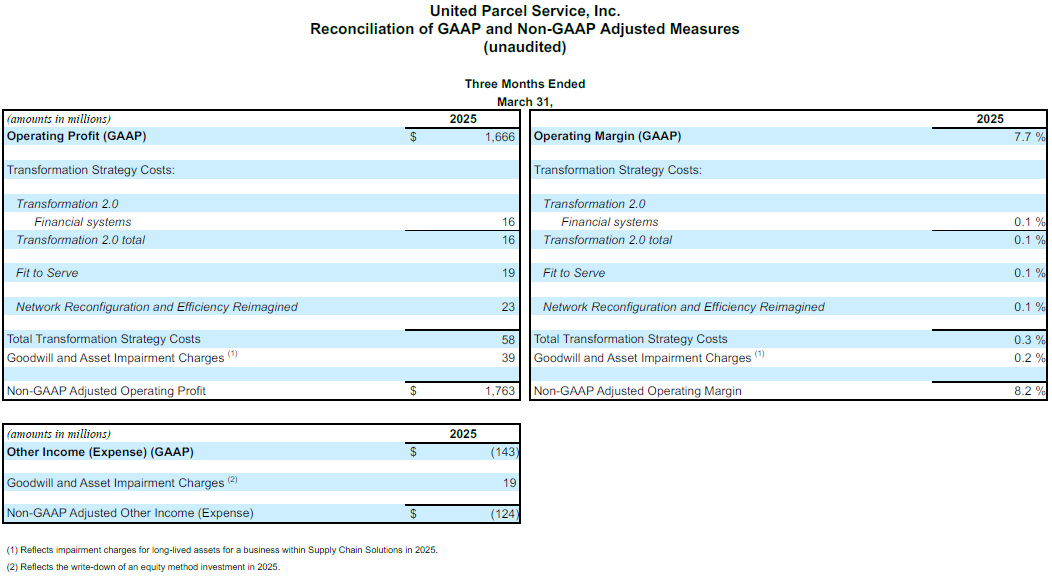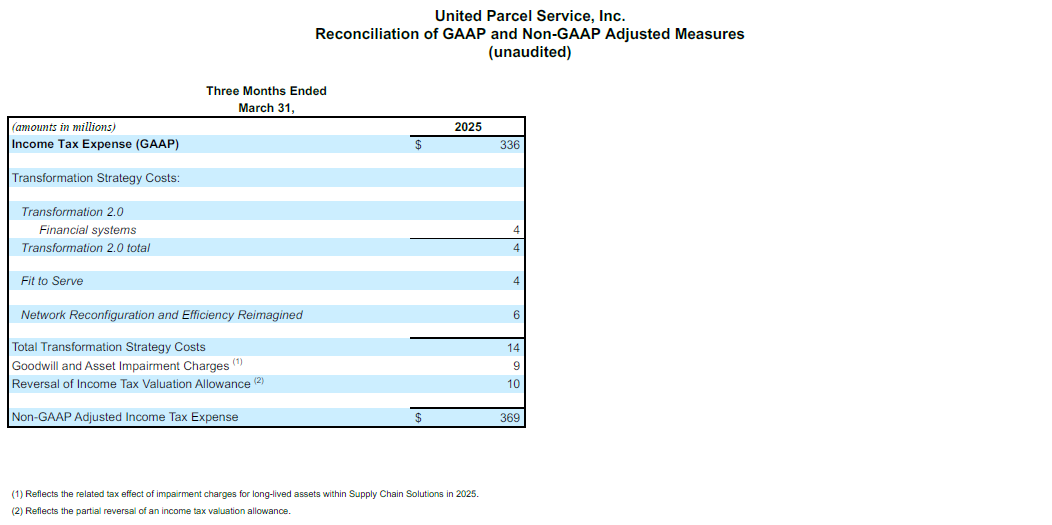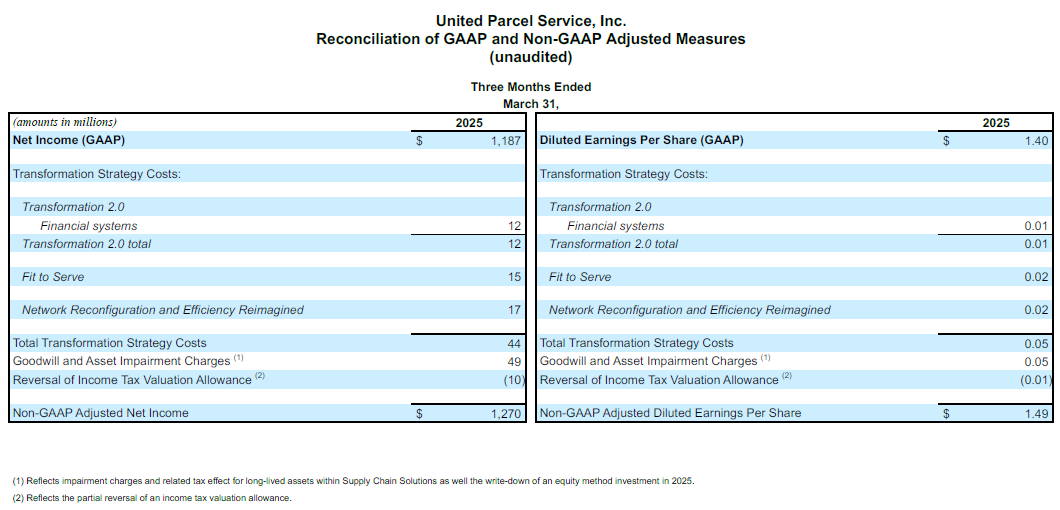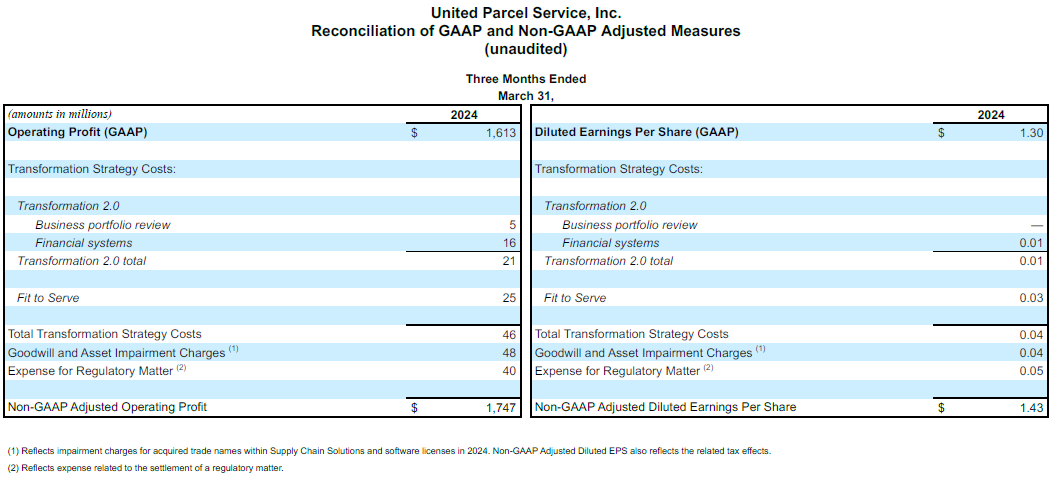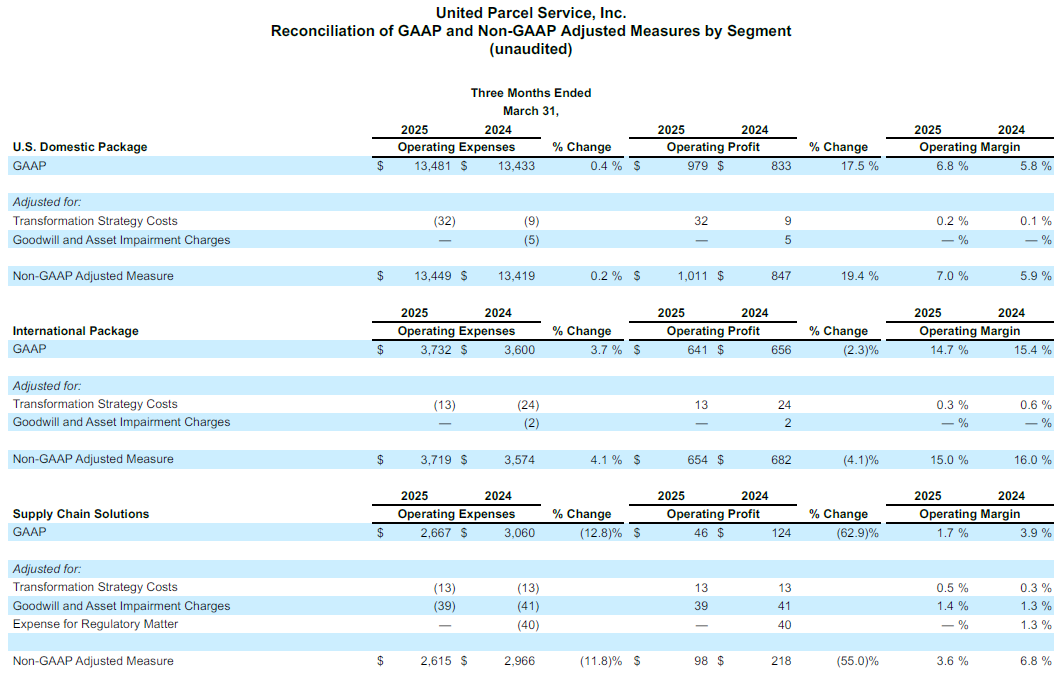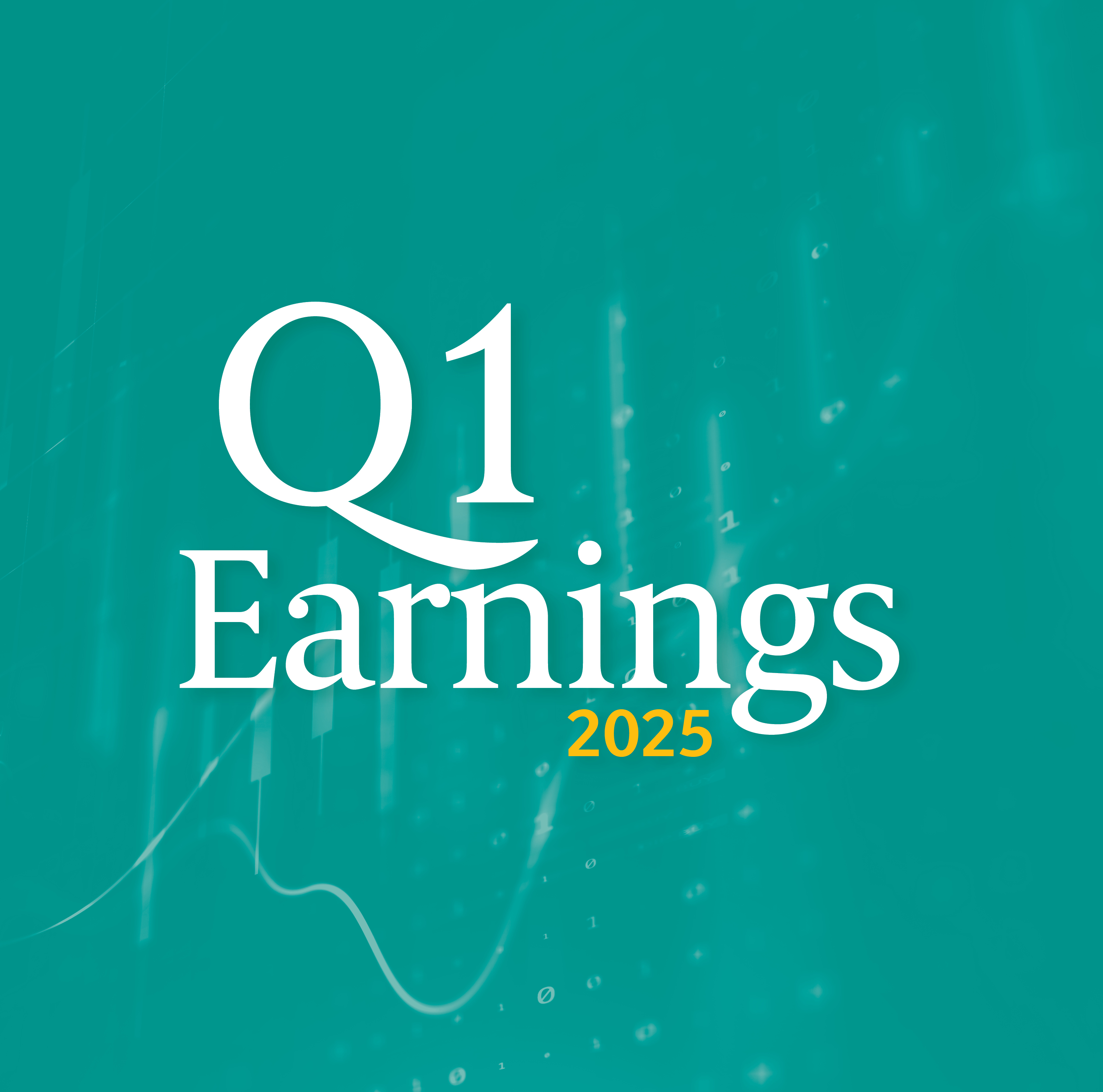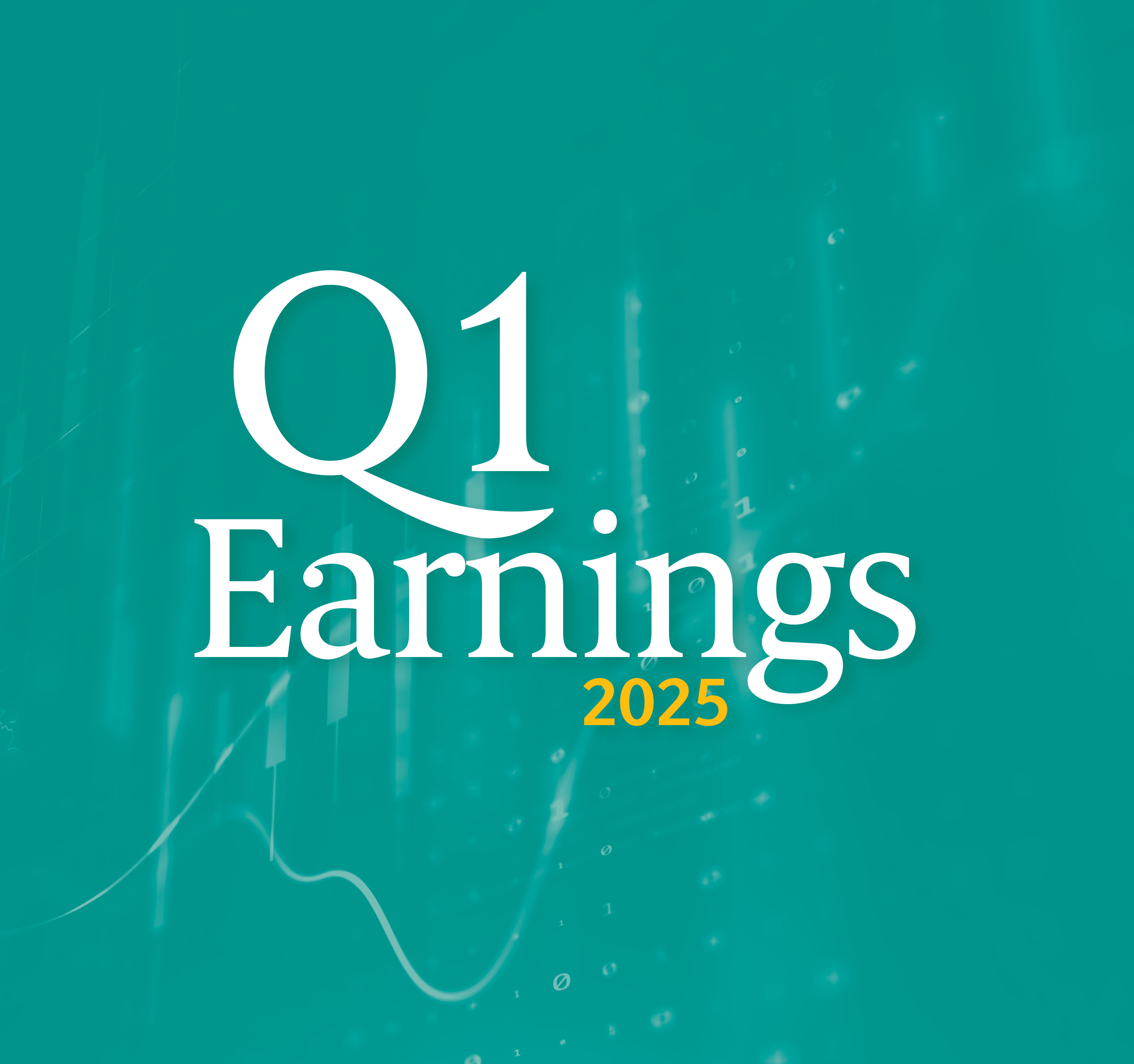- Consolidated Revenues of $21.5B, Compared to $21.7B Last Year
- Consolidated Operating Margin of 7.7%; Non-GAAP Adjusted* Consolidated Operating Margin of 8.2%
- Diluted EPS of $1.40; Non-GAAP Adj. Diluted EPS of $1.49, Compared to $1.43 Last Year
ATLANTA – April 29, 2025 – UPS (NYSE:UPS) today announced first-quarter 2025 consolidated revenues of $21.5 billion, a 0.7% decrease from the first quarter of 2024. Consolidated operating profit was $1.7 billion, up 3.3% compared to the first quarter of 2024, and up 0.9% on a non-GAAP adjusted basis. Diluted earnings per share were $1.40 for the quarter; non-GAAP adjusted diluted earnings per share were $1.49, 4.2% above the same period in 2024.
For the first quarter of 2025, GAAP results include a net charge of $83 million, or $0.09 per diluted share, comprised of after-tax transformation strategy costs of $44 million and a non-cash, after-tax impairment charge of $49 million, primarily related to asset and investment impairments. These charges were partially offset by a $10 million benefit for the partial reversal of an income tax valuation allowance.
“I want to thank all UPSers for their hard work and efforts in this very dynamic environment,” said Carol Tomé, UPS chief executive officer. “As a trusted leader in global logistics, we will leverage our integrated network and trade expertise to assist our customers as they adapt to a changing trade environment. Further, the actions we are taking to reconfigure our network and reduce cost across our business could not be timelier. The macro environment may be uncertain, but with our actions, we will emerge as an even stronger, more nimble UPS.”
U.S. Domestic Segment†
| 1Q 2025 | Non-GAAP Adjusted 1Q 2025 | 1Q 2024 | Non-GAAP Adjusted 1Q 2024 |
Revenue | $14,460 M |
| $14,266 M |
|
Operating profit | $979 M | $1,011 M | $833 M | $847 M |
- Revenue grew 1.4%, driven by increases in air cargo and a 4.5% improvement in revenue per piece, which partially offset a decline in volume.
- Operating margin was 6.8%; non-GAAP adjusted operating margin was 7.0%.
International Segment
| 1Q 2025 | Non-GAAP Adjusted 1Q 2025 | 1Q 2024 | Non-GAAP Adjusted 1Q 2024 |
Revenue | $4,373 M |
| $4,256 M |
|
Operating profit | $641 M | $654 M | $656 M | $682 M |
- Revenue increased 2.7%, driven by a 7.1% increase in average daily volume.
- Operating margin was 14.7%; non-GAAP adjusted operating margin was 15.0%.
Supply Chain Solutions1 †
| 1Q 2025 | Non-GAAP Adjusted 1Q 2025 | 1Q 2024 | Non-GAAP Adjusted 1Q 2024 |
Revenue | $2,713 M |
| $3,184 M |
|
Operating profit | $46 M | $98 M | $124 M | $218 M |
1 Consists of operating segments that do not meet the criteria of a reportable segment under ASC Topic 280 – Segment Reporting.
- Revenue declined 14.8%, primarily due to the divestiture of Coyote.
- Operating margin was 1.7%; non-GAAP adjusted operating margin was 3.6%.
2025 Outlook
Given the current macro-economic uncertainty, the company is not providing any updates to its previously issued consolidated full-year outlook. Expectations for its second-quarter financial performance will be provided during its first-quarter 2025 earnings conference call and webcast.
* “Non-GAAP Adjusted” or “Non-GAAP Adj.” amounts are non-GAAP adjusted financial measures. See the appendix to this release for a discussion of non-GAAP adjusted financial measures, including a reconciliation to the most closely correlated GAAP measure.
† Certain prior year amounts have been reclassified to conform to the current year presentation, including the recast of air cargo results to U.S. Domestic, with no change to consolidated results. Certain amounts are calculated based on unrounded numbers.
Contacts:
UPS Media Relations: 404-828-7123 or pr@ups.com
UPS Investor Relations: 404-828-6059 (option 4) or investor@ups.com
Conference Call Information
UPS CEO Carol Tomé and CFO Brian Dykes will discuss first-quarter results with investors and analysts during a conference call at 8:30 a.m. ET, April 29, 2025. That call will be open to others through a live Webcast. To access the call, go to www.investors.ups.com and click on “Earnings Conference Call.” Additional financial information is included in the detailed financial schedules being posted on www.investors.ups.com under “Quarterly Earnings and Financials” and as furnished to the SEC as an exhibit to our Current Report on Form 8-K.
About UPS
UPS (NYSE: UPS) is one of the world’s largest companies, with 2024 revenue of $91.1 billion, and provides a broad range of integrated logistics solutions for customers in more than 200 countries and territories. Focused on its purpose statement, “Moving our world forward by delivering what matters,” the company’s approximately 490,000 employees embrace a strategy that is simply stated and powerfully executed: Customer First. People Led. Innovation Driven. UPS is committed to reducing its impact on the environment and supporting the communities we serve around the world. More information can be found at www.ups.com, about.ups.com and www.investors.ups.com.
Forward-Looking Statements
This release, our Annual Report on Form 10-K for the year ended December 31, 2024 and our other filings with the Securities and Exchange Commission contain and in the future may contain “forward-looking statements”. Statements other than those of current or historical fact, and all statements accompanied by terms such as “will,” “believe,” “project,” “expect,” “estimate,” “assume,” “intend,” “anticipate,” “target,” “plan,” and similar terms, are intended to be forward-looking statements.
From time to time, we also include written or oral forward-looking statements in other publicly disclosed materials. Forward-looking statements may relate to our intent, belief, forecasts of, or current expectations about our strategic direction, prospects, future results, or future events; they do not relate strictly to historical or current facts. Management believes that these forward-looking statements are reasonable as and when made. However, caution should be taken not to place undue reliance on any forward-looking statements because such statements speak only as of the date when made and the future, by its very nature, cannot be predicted with certainty.
Forward-looking statements are subject to certain risks and uncertainties that could cause actual results to differ materially from our historical experience and our present expectations or anticipated results. These risks and uncertainties include, but are not limited to: changes in general economic conditions in the U.S. or internationally, including as a result of changes in the global trade policy and new or increased tariffs; significant competition on a local, regional, national and international basis; changes in our relationships with our significant customers; our ability to attract and retain qualified employees; strikes, work stoppages or slowdowns by our employees; increased or more complex physical or operational security requirements; a significant cybersecurity incident, or increased data protection regulations; our ability to maintain our brand image and corporate reputation; impacts from global climate change; interruptions in or impacts on our business from natural or man-made events or disasters including terrorist attacks, epidemics or pandemics; exposure to changing economic, political, regulatory and social developments in international and emerging markets; our ability to realize the anticipated benefits from acquisitions, dispositions, joint ventures or strategic alliances; the effects of changing prices of energy, including gasoline, diesel, jet fuel, other fuels and interruptions in supplies of these commodities; changes in exchange rates or interest rates; our ability to accurately forecast our future capital investment needs; increases in our expenses or funding obligations relating to employee health, retiree health and/or pension benefits; our ability to manage insurance and claims expenses; changes in business strategy, government regulations or economic or market conditions that may result in impairments of our assets; potential additional U.S. or international tax liabilities; increasingly stringent regulations related to climate change; potential claims or litigation related to labor and employment, personal injury, property damage, business practices, environmental liability and other matters; and other risks discussed in our filings with the Securities and Exchange Commission from time to time, including our Annual Report on Form 10-K for the year ended December 31, 2024, and subsequently filed reports. You should consider the limitations on, and risks associated with, forward-looking statements and not unduly rely on the accuracy of predictions contained in such forward-looking statements. We do not undertake any obligation to update forward-looking statements to reflect events, circumstances, changes in expectations, or the occurrence of unanticipated events after the date of those statements, except as required by law.
The Company routinely posts important information, including news releases, announcements, materials provided or displayed at analyst or investor conferences, and other statements about its business and results of operations, that may be deemed material to investors on the Company’s Investors Relations website at www.investors.ups.com. The Company uses its website as a means of disclosing material, nonpublic information and for complying with the Company’s disclosure obligations under Regulation FD. Investors should monitor the Company’s Investor Relations website in addition to following the Company’s press releases, filings with the SEC, public conference calls and webcasts. We do not incorporate the contents of any website into this or any other report we file with the SEC.
Reconciliation of GAAP and Non-GAAP Adjusted Financial Measures
We supplement the reporting of our financial information determined under generally accepted accounting principles ("GAAP") with certain non-GAAP adjusted financial measures. Management views and evaluates business performance on both a GAAP basis and by excluding costs and benefits associated with these non-GAAP adjusted financial measures. As a result, we believe the presentation of these non-GAAP adjusted financial measures better enables users of our financial information to view and evaluate underlying business performance from the same perspective as management.
Non-GAAP adjusted financial measures should be considered in addition to, and not as an alternative for, our reported results prepared in accordance with GAAP. Our non-GAAP adjusted financial measures do not represent a comprehensive basis of accounting and therefore may not be comparable to similarly titled measures reported by other companies.
Forward-Looking Non-GAAP Adjusted Financial Metrics
From time to time when presenting forward-looking non-GAAP metrics, we are unable to provide quantitative reconciliations to the most closely correlated GAAP measure due to the uncertainty in the timing, amount or nature of any adjustments, which could be material in any period.
Expense for Regulatory Matter
We supplement our presentation with non-GAAP measures that exclude the impact of an expense to settle a regulatory matter that we consider to be unrelated to our ongoing operations and that we do not expect to recur.
Transformation Strategy Costs
We supplement our presentation with non-GAAP measures that exclude the impact of charges related to activities within our transformation strategy. Our transformation strategy activities have spanned several years and are designed to fundamentally change the spans and layers of our organization structure, processes, technologies and the composition of our business portfolio. Our transformation strategy includes initiatives within our Transformation 2.0, Fit to Serve, Network Reconfiguration and Efficiency Reimagined programs.
Various circumstances from time to time have precipitated these initiatives, including identification and prioritization of investments as a result of executive leadership changes, developments and changes in competitive landscapes, inflationary pressures, consumer behaviors, and other factors including post-COVID normalization and volume diversions attributed to our 2023 labor negotiations.
Our transformation strategy has included the following programs and initiatives:
Transformation 2.0: We identified opportunities to reduce spans and layers of management, began a review of our business portfolio and identified opportunities to invest in certain technologies, including financial reporting and certain schedule, time and pay systems, to reduce global indirect operating costs, provide better visibility, and reduce reliance on legacy systems and coding languages. Costs associated with Transformation 2.0 have primarily consisted of compensation and benefit costs related to reductions in our workforce and fees paid to third-party consultants. We expect any remaining costs to be incurred during 2025.
Fit to Serve: We undertook our Fit to Serve initiative with the intent to right-size our business to create a more efficient operating model that was more responsive to market dynamics through a workforce reduction of approximately 14,000 positions, primarily within management. Fit to Serve is expected to conclude in 2025.
Network Reconfiguration and Efficiency Reimagined: Our Network of the Future initiative is intended to enhance the efficiency of our network through automation and operational sort consolidation in our U.S. Domestic network. In connection with our anticipation of lower volumes from our largest customer, we began our Network Reconfiguration, which is an expansion of Network of the Future and will lead to consolidations of our facilities and workforce as well as an end-to-end process redesign. We launched our Efficiency Reimagined initiatives to undertake the end-to-end process redesign effort which will align our organizational processes to the network reconfiguration. We expect to reduce our operational workforce by approximately 20,000 positions during 2025 and close 73 leased and owned buildings by the end of June 2025. We are continuing to review our network and may identify additional buildings for closure. As of March 31, 2025, we continue to evaluate the impact of expected changes in volume on our air network. We anticipate $3.5 billion of total cost savings will be delivered from Network Reconfiguration and Efficiency Reimagined in 2025.
In connection with the Network Reconfiguration and Efficiency Reimagined programs described above, we expect to record between $400 and $600 million in expense during 2025, related to early asset retirements, lease related costs, third-party consulting fees and employee separation benefits. We expect the costs associated with these actions may increase should we determine to close additional buildings. It is our intention to sell the property and equipment associated with closed facilities; however, as of the date hereof, we have not yet formalized plans of sale. In addition, we believe that workforce reductions may require a remeasurement of defined benefit plan benefit obligations and assets during 2025. We are not yet able to estimate the timing or potential impact of such an event. During the first quarter of 2025, we realized benefits of approximately $80 million and incurred related costs of $23 million from this program. These initiatives are expected to end in 2027.
We do not consider the related costs to be ordinary because each program involves separate and distinct activities that may span multiple periods and are not expected to drive incremental revenue, and because the scope of the programs exceeds that of routine, ongoing efforts to enhance profitability. These initiatives are in addition to ordinary, ongoing efforts to enhance business performance.
Goodwill and Asset Impairments
We supplement our presentation with non-GAAP measures that exclude the impact of goodwill and asset impairment charges, including impairments of long-lived assets and equity method investments. We do not consider these charges when evaluating the operating performance of our business units, making decisions to allocate resources or in determining incentive compensation awards.
Reversal of Income Tax Valuation Allowance
We previously recorded non-GAAP adjustments for transactions that resulted in capital loss deferred tax assets not expected to be realized. We now expect a portion of these capital losses to be realized in future periods. We supplement our presentation with non-GAAP measures that exclude the impact of subsequent changes in the valuation allowances against these deferred tax assets as we believe such treatment is consistent with how the valuation allowance was initially established.
Non-GAAP Adjusted Cost per Piece
We evaluate the efficiency of our operations using various metrics, including non-GAAP adjusted cost per piece. Non-GAAP adjusted cost per piece is calculated as non-GAAP adjusted operating expenses in a period divided by total volume for that period. Because non-GAAP adjusted operating expenses exclude costs or charges that we do not consider a part of underlying business performance when monitoring and evaluating the operating performance of our business units, making decisions to allocate resources or in determining incentive compensation awards, we believe this is the appropriate metric on which to base reviews and evaluations of the efficiency of our operational performance.
Free Cash Flow
We calculate free cash flow as cash flows from operating activities less capital expenditures, proceeds from disposals of property, plant and equipment, and plus or minus the net changes in other investing activities. We believe free cash flow is an important indicator of how much cash is generated by our ongoing business operations and we use this as a measure of incremental cash available to invest in our business, meet our debt obligations and return cash to shareowners.
